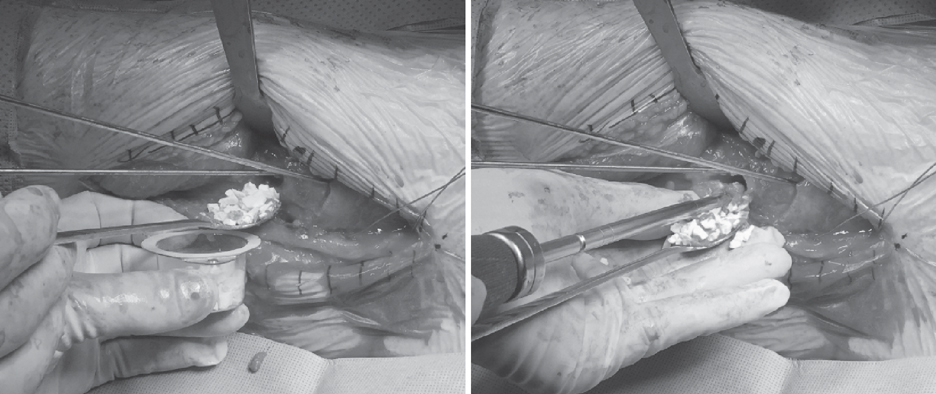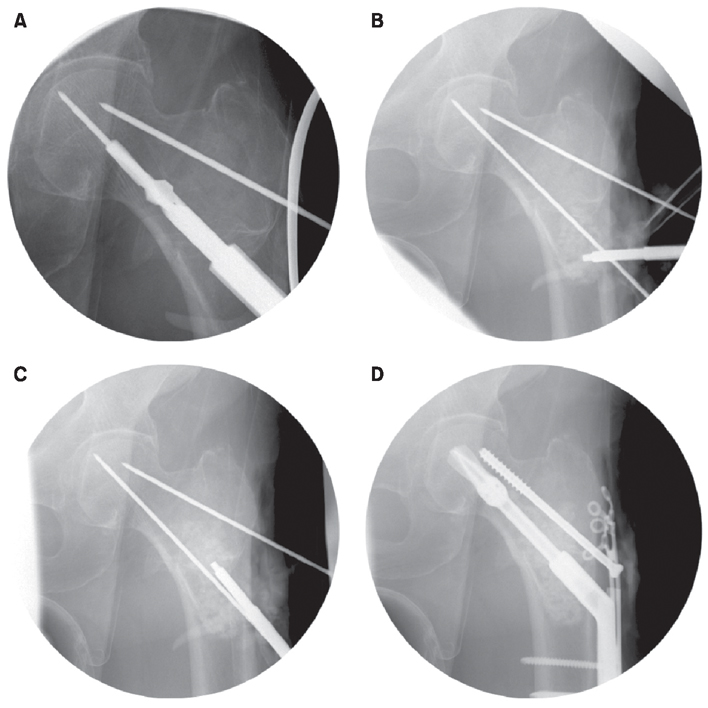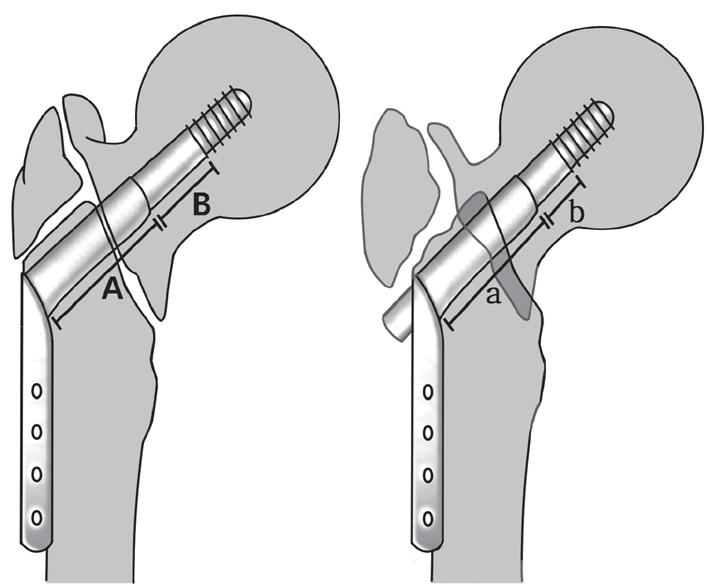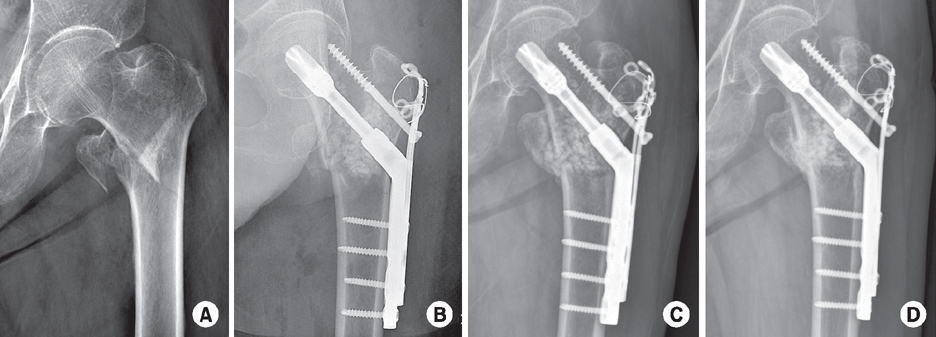J Korean Fract Soc.
2016 Oct;29(4):250-257. 10.12671/jkfs.2016.29.4.250.
The Role of Beta-Tricalcium Phosphate Graft in the Dynamic Hip Screw Fixation of Unstable Intertrochanter Fracture
- Affiliations
-
- 1Department of Orthopedic Surgery, Asan Medical Center, Ulsan University College of Medicine, Seoul, Inje University College of Medicine, Busan, Korea. jschang@amc.seoul.kr
- 2Department of Orthopedic Surgery, Inje University Haeundae Paik Hospital, Inje University College of Medicine, Busan, Korea.
- KMID: 2355430
- DOI: http://doi.org/10.12671/jkfs.2016.29.4.250
Abstract
- PURPOSE
The purpose of this study was to introduce our method of stabilizing unstable intertrochanteric fractures by using the dynamic hip screw (DHS) with a beta-tricalcium phosphate (β-TCP) graft and to compare the outcomes of this procedure with those of the conventional DHS without β-TCP.
MATERIALS AND METHODS
Patients who underwent surgery by using DHS between March 2002 and January 2016 were retrospectively reviewed for analysis of the outcomes. The inclusion criteria were: 1) age of 60 years and older; 2) low-energy fracture resulting from a fall from no greater than the standing height; 3) multifragmentary pertrochanteric fracture (AO classification 31-A2.2, 2.3); and 4) follow-up of over 3 months. We compared 29 patients (29 hips) who underwent surgery, using DHS without β-TCP, with 29 age-sex matched patients (29 hips) who underwent surgery using DHS with grafted β-TCP granules to empty the trochanter area after reaming. We investigated the fracture union rate, union time, and length of lag screw sliding.
RESULTS
Bone union was achieved in all cases. The mean union time was 7.0 weeks in the β-TCP group and 8 .8 weeks in the non-β-TCP group. The length of lag screw sliding was 3.6 mm in the β-TCP group and 5 .5 mm in the non-β-TCP group. There were no implant failure cases in both groups.
CONCLUSION
The β-TCP graft for reinforcement DHS acquired satisfactory clinical outcomes for treating unstable intertrochanteric fractures.
MeSH Terms
Figure
Reference
-
1. National Health Insurance Service. NHIS statistical information system [Internet]. Wonju: National Health Insurance Service;2015. Oct 19. Available from: http://www.nhis. or.kr/bbs7/boards/B0039/15329.2. Jensen JS, Sonne-Holm S, Tøndevold E. Unstable trochanteric fractures. A comparative analysis of four methods of internal fixation. Acta Orthop Scand. 1980; 51:949–962.
Article3. Koval KJ, Zuckerman JD. Hip fractures: II. Evaluation and treatment of intertrochanteric fractures. J Am Acad Orthop Surg. 1994; 2:150–156.
Article4. Sambandam SN, Chandrasekharan J, Mounasamy V, Mauffrey C. Intertrochanteric fractures: a review of fixation methods. Eur J Orthop Surg Traumatol. 2016; 26:339–353.
Article5. Laros GS, Moore JF. Complications of fixation in intertrochanteric fractures. Clin Orthop Relat Res. 1974; (101):110–119.6. Stankewich CJ, Swiontkowski MF, Tencer AF, Yetkinler DN, Poser RD. Augmentation of femoral neck fracture fixation with an injectable calcium-phosphate bone mineral cement. J Orthop Res. 1996; 14:786–793.
Article7. Lu JX, Huang ZW, Tropiano P, et al. Human biological reactions at the interface between bone tissue and polymethylmethacrylate cement. J Mater Sci Mater Med. 2002; 13:803–809.8. Stoffel KK, Leys T, Damen N, Nicholls RL, Kuster MS. A new technique for cement augmentation of the sliding hip screw in proximal femur fractures. Clin Biomech (Bristol, Avon). 2008; 23:45–51.
Article9. Fillingham Y, Jacobs J. Bone grafts and their substitutes. Bone Joint J. 2016; 98-B:1 Suppl A. 6–9.
Article10. Neamat A, Gawish A, Gamal-Eldeen AM. Beta-tricalcium phosphate promotes cell proliferation, osteogenesis and bone regeneration in intrabony defects in dogs. Arch Oral Biol. 2009; 54:1083–1090.
Article11. Baumgaertner MR, Curtin SL, Lindskog DM, Keggi JM. The value of the tip-apex distance in predicting failure of fixation of peritrochanteric fractures of the hip. J Bone Joint Surg. 1995; 77:1058–1064.
Article12. Kyle RF, Ellis TJ, Templeman DC. Surgical treatment of intertrochanteric hip fractures with associated femoral neck fractures using a sliding hip screw. J Orthop Trauma. 2005; 19:1–4.
Article13. Doppelt SH. The sliding compression screw: today's best answer for stabilization of intertrochanteric hip fractures. Orthop Clin North Am. 1980; 11:507–523.
Article14. Kim KJ, Yang DS, Lee SK, Choy WS, Bae KW. Surgical treatment of femoral unstable intertrochanteric fractures in elderly patients: comparative study between compressive hip screws and additional trochanteric stabilizing plates. J Korean Fract Soc. 2011; 24:295–300.
Article15. Flores LA, Harrington IJ, Heller M. The stability of intertrochanteric fractures treated with a sliding screw-plate. J Bone Joint Surg Br. 1990; 72:37–40.
Article16. Davis TR, Sher JL, Horsman A, Simpson M, Porter BB, Checketts RG. Intertrochanteric femoral fractures. Mechanical failure after internal fixation. J Bone Joint Surg Br. 1990; 72:26–31.
Article17. Min BW, Lee KJ. Treatment of intertrochanteric fracture: dynamic hip screw. J Korean Fract Soc. 2009; 22:51–55.
Article18. Lindner T, Kanakaris NK, Marx B, Cockbain A, Kontakis G, Giannoudis PV. Fractures of the hip and osteoporosis: the role of bone substitutes. J Bone Joint Surg Br. 2009; 91:294–303.19. Hofmann-Fliri L, Nicolino TI, Barla J. Cement augmentation of implants: no general cure in osteoporotic fracture treatment. A biomechanical study on non-displaced femoral neck fractures. J Orthop Res. 2016; 34:314–319.
Article20. Yoo JH, Kim TY, Chang JD, Kwak YH, Kwon YS. Factors influencing functional outcomes in united intertrochanteric hip fractures: a negative effect of lag screw sliding. Orthopedics. 2014; 37:e1101–e1107.
Article
- Full Text Links
- Actions
-
Cited
- CITED
-
- Close
- Share
- Similar articles
-
- The Neccessity of Additional Supporting Fixation for the Unstable Intertrochanteric Fractures of the Femur in the Elderly
- Fixation Failure of Unstable Intertrochanteric Fracture of the Femur Using Compression Hip Screw
- Femoral Neck Fracture Fixation (Comparison of Dynamic Hip Screw and Cannulated Screw Fixation)
- Treatment of Unstable Interochanteric Femoral Fracture using Compression Hip Screw with additional Transfixations Screw
- The Complication in the Treatment Modality of Intertrochanteric Fracture of Femur





